
|
The Italian Avantgarde in Car Design Show
Sept 19 - Oct 6th 2002

|
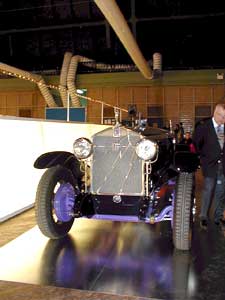 The Isotta Fraschini 8A was an example of the era of Art Nouveau. Isottas were the choice of many Hollywood movie stars of the 1920s.
The Isotta Fraschini 8A was an example of the era of Art Nouveau. Isottas were the choice of many Hollywood movie stars of the 1920s.
|
September 30, 2002
By Pete Vack
All Photos by Sue Dixon
First and foremost, VeloceToday would like to sincerely thank Bruno Alfieri and the Italian Trade Commission for creating a very interesting and necessary display of Italian automotive design. We say interesting because obviously we are enamored with Italian cars and design. We say necessary because there are few venues to demonstrate and explain Italian automotive art and design, particularly on the East Coast. The show, which runs from September 19th to October 6th, was organized by ANFIA (Motor Vehicle Manufacturer Association of Italy) and the Italian Trade Commission, and conceived by Alfieri’s publishing company, Automobilia. Part of a campaign called “Italia-- Life in I style”, the effort hopefully strengthens links between Italy and the U.S., while associating Italian car design with various periods of art and culture. One of the prime goals of the Avantgarde effort is to “…create a synergy between industrial design and automotive design.”
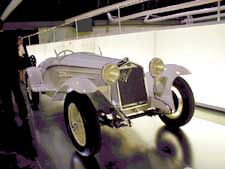 Tazio Nuvolari’s personal Alfa, an 8C 2300 Spider Corto with a Zagato body. When he brought it to New York for the 1936 Vanderbuilt Cup, Baron Collier made him an offer he couldn’t refuse. Found under Art Deco.
Tazio Nuvolari’s personal Alfa, an 8C 2300 Spider Corto with a Zagato body. When he brought it to New York for the 1936 Vanderbuilt Cup, Baron Collier made him an offer he couldn’t refuse. Found under Art Deco.
|
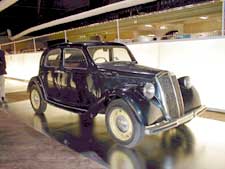 The Aprilia was really a pre War design but post war in concept and advanced engineering. This example is owned by Howard Moon. Included in the “Rolling Sculpture” section.
The Aprilia was really a pre War design but post war in concept and advanced engineering. This example is owned by Howard Moon. Included in the “Rolling Sculpture” section.
|
|
To do this, the display was aligned with twentieth century schools of design. A new movement (variously termed Art Nouveau, Liberty Style in Italy, and in Germany, Jugenstil) at the beginning of the century didn’t limit itself to simply beautifying the environment. Along with the industrial revolution, the new style allowed art to be not only part of the landscape, but also an intrinsic to the function of products as well. Obviously and with impact, this also coincided with the birth and development of the automobile.

|
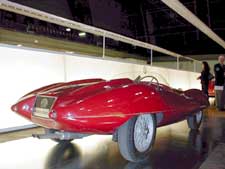 Connect the dots from the original Disco to the XKE. Unfortunately the original didn’t perform as good as it looked.
Connect the dots from the original Disco to the XKE. Unfortunately the original didn’t perform as good as it looked.
|
Art Nouveau is represented by the Fiat Bravo Torpedo of 1915 and the Isotta Fraschini. Automobiles built during the Art Deco period, popular from about 1925 to WWII, “…seemed to draw their inspiration from the typical style of Art Deco”, according to the organizers. This group included the Touring-bodied Alfas, Lancia Lambda, and the Type 57 Bugatti Atlantic coupe. The period from WWII to 1970 was a bit more problematic. Here, the organizing committee took a cue from Arthur Drexler, the curator of New York’s MOMA who coined the term “Rolling Sculpture”. “Rolling Sculpture” is demonstrated by a large number of cars, the most significant of which are perhaps the Lancia Aprilia, the Cisitalia 202 (the same one Drexler displayed at MOMA in 1951), an Alfa Giulietta Sprint coupe, the 250 LM Ferrari and finally the Daytona Spider. A category called “The Era of Car Design” (“renewing the very concept of the automobile with an eye toward absolute functionalism”) takes one from 1970s, with the Ghibli Spyder to the 1989 Maserati Shamal, designed by Marcello Gandini. Finally, the “New Wave” takes us from the 360 Modena to the new Enzo. According to Alfieri, the current era (art or not) “demonstrate full expressive maturity, in their blend of plasticism, new technologies, and functionalism.”
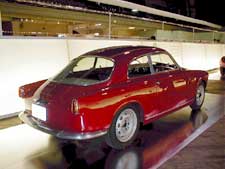 Sue says this Alfa is a lightweight model and was great. Like true art, it often takes time to recognize a great car. The Sprint ranks as one of Italy’s best post war designs.
Sue says this Alfa is a lightweight model and was great. Like true art, it often takes time to recognize a great car. The Sprint ranks as one of Italy’s best post war designs.
|
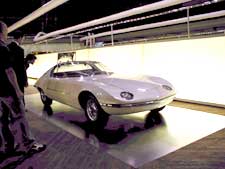 Corvair by Giugiaro—the Testudo. Provacative. Reader’s opinions welcome.
Corvair by Giugiaro—the Testudo. Provacative. Reader’s opinions welcome.
|
|
In the catalogue, Alfieri loquaciously associates automotive design with artists and art, and at times somewhat convincingly. And as Alfieri points out, the automobile is almost unique in that it is both a functional product, but a primary example of industrial art, often on a very high level. Art and the automobile convene in a special way with great impact on both the consumer and connoisseur. Today’s automobile entails and utilizes the greatest degree of high technology, is built and designed by a sophisticated and specialized team bound by thousands of artificial and real constraints. Despite this, particularly in Italy, they still manage to create significant and beautiful automobiles. The Enzo and the Murcielago are but two examples.
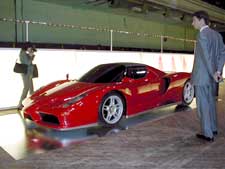 We skip to the Italian New Wave. The Enzo just keeps on growing on one. Sue Dixon note, however, that the Lambo upstaged the Enzo big time.
We skip to the Italian New Wave. The Enzo just keeps on growing on one. Sue Dixon note, however, that the Lambo upstaged the Enzo big time.
|
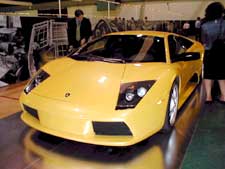 The Murcielago too, gets more attractive the more one sees it. More conservative than the Enzo, a switch for Lamborghini.
The Murcielago too, gets more attractive the more one sees it. More conservative than the Enzo, a switch for Lamborghini.
|
|
The Italians excel in automotive design on a scale no one else has been able to achieve. That is what Avantgarde in Car Design is trying to get across, and has made an admirable attempt to do so. The exhibition seems to be planned with the educated public in mind, not specifically those interested in automobiles. This is for the good, as attention should be directed towards raising the interest and awareness of a wider, and influential audience.
While we are not in total agreement with the selection of cars, in regards to both the models and the particular examples displayed, we do agree that to include Bugatti is appropriate. Whether Ettore lived in France, Germany, Italy or Alsace-Lorriane, he was Italian by birth, temperament and training. And to provide an example of a honest Atlantic coupe (courtesy Ralph Lauren) makes the show worth seeing.
We recommend that you see the Italian Avantegarde in Car Design if you can make it. It’s not Concorso, it’s not Pebble or Cavallino. It’s on another level entirely, and certainly worth supporting.
Tickets are $10, Catalogue is $30. Address is 69th Regiment Armory, 68 Lexington Avenue, New York.
|

|